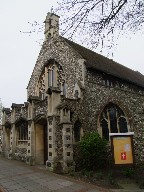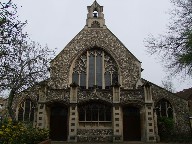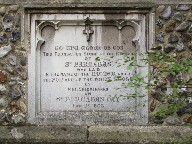
home I index I latest I glossary I introductions I e-mail I about this site
St Barnabas, Heigham, Norwich
Read
the captions by hovering over the images, and click on them to
see them enlarged.



St
Barnabas, Heigham, Norwich
I came here on a Thursday morning in July 2009. It was the start of the summer holidays, and I was pottering around Norwich in a pleasingly aimless kind of way. I'd wanted to come to St Barnabas for some time, having seen photographs of the glass inside, and it was with some excitement that I found the church open. I stepped inside to a dim interior infused with colour from the glass. The mid-week parish Eucharist was taking place in the north aisle. I am not an Anglican myself, but I know the service well enough, and it was a pleasure to sit on the cool pedestal of the font and listen to those gentle words which go back so far. A brass plaque beside my head commemorated the high water mark of the great Norwich flood of 1912. There were about twenty people in the congregation, nice to see on a Thursday morning, and another reminder that the death of the Church of England has been greatly exaggerated. The service finished, and I said hello to the Priest. She was very friendly, as were the churchwardens, and the other members of the congregation. I think I must have shaken hands with nearly all of them. What a lovely bunch of people. They were very pleased that someone was interested in their church, particularly as they did not get many visitors on the last Heritage Open Day. Perhaps my photographs would help attract more interest? I said I would see what I could do. St Barnabas has the effect of seeming much larger inside than it appears from outside, and this is partly because of the way the steps climb into the chancel, with the great east window beyond. This contains what is probably the best Kempe window in Norwich, and there is more Kempe glass in the east window of the north aisle. But best of all, I liked all the post-war glass, the work of the Essex-based artist Alfred Wilkinson. It starts in 1947, with the Presentation in the Temple in the five-light baptistery window. The High Priest holds the infant Christ: to the left, Mary holds the two doves, with Joseph holding lilies behind her. To the right, Simeon and Anna hold the scrolls of the Nunc Dimmitis. It is a solemn moment, caught with gravitas, and perhaps it is not fanciful to read into it the gathering of thoughts in this part of war-torn Norwich at the time. By the 1950s, however, there was a lightening of heart, and in the north and south aisles are further Wilkinson windows. Perhaps the best-known is that in the north aisle, a thank-offering from friends of this church for blessings received during its first fifty years 1906-1956. A spectacular Christ welcomes the children into his arms, while on one side are a Scout and a Cub, on the other a Brownie and a Guide. Across the church, a Blessed Virgin and Child are flanked by St Paul and St Barnabas, while to the west the Risen Christ is flanked by scenes from Bethany: to the west, Christ is greeted by Mary and Martha, while to the east is the later raising of Lazarus. The Wilkinson windows have such a bright and joyful spirit that they make the Kempe windows seem more ponderous than they really are. The great east window, an expanse of glass of cathedralesque proportions, depicts the Risen Christ flanked by censing angels and angel musicians, while below his feet are four large figures of St Michael, St Martin, St Nicholas and St George, with Gethsemane and Calvary flanking the central scene of the the three Marys finding the stone rolled back and the tomb empty. I think that, in Norfolk, only the Kempe window at Horstead is more impressive. The glass in the north aisle east window depicts a rather crowded Nativity, and is less good.
|
Simon Knott, July 2009
Amazon commission helps cover the running costs of this site.
home I index I latest I introductions I e-mail I about
this site I glossary
Norwich I ruined churches I desktop backgrounds I round tower churches
links I small
print I www.simonknott.co.uk I www.suffolkchurches.co.uk